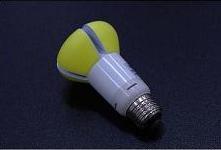How many innovative companies does it take to change a light bulb? Only one, if there’s a prize involved.

Recently, the U.S. Department of Energy announced the winner of the $10 million L-Prize, a competition to create a light bulb capable of producing as much light as a 60 watt incandescent bulb but using less than 10 watts of energy, an 83 percent reduction in energy use. The Department of Energy estimates that if Americans replaced all of their current 60 watt bulbs with the winning entry from Philips, we’d save $3.9 billion in energy costs per year. The Department of Energy has partnered with over 30 regionally based utility companies and organizations to help make this a reality.
It is worth reading about the competition requirements, as described by the Department of Energy. For example,
The L Prize competition includes technical specifications to ensure compliance with the general requirements outlined in the legislation, with additional details specified for quality, performance, and mass manufacturing. The competition also includes a rigorous evaluation process for proposed products, designed to detect and address product weaknesses before market introduction, to avoid problems with long-term market acceptance."
This sounds strikingly similar to Jim Shelton’s post on Wednesday on the meaning of true innovations: developments that can both produce dramatic impact AND be brought to scale. Education innovation may not be as easy as light bulbs, because high-quality implementation is always needed. Education innovators, especially non-profits, do not have the capital to compete for a large prize in hopes of making back the money in prizes or sales. Yet the basic idea could easily transfer to education. Imagine the federal government set out standards of “performance (learning), quality, cost, and availability” for beginning reading, or middle school math, or high school biology. They might support alternative proposals to solve the problems, funding the most innovative, experienced, and capable developers to create and pilot solutions, ultimately to be independently evaluated on widely accepted measures. Through partnerships with education non-profits, state education agencies, and foundations, solutions that work can then be disseminated to schools throughout the U.S.
Investing in Innovation (i3), the Obama Administration’s investment in the whole innovation pipeline from development to scale-up, is a bit like the L-Prize, in that programs that obtain positive achievement outcomes in rigorous, third-party evaluations may qualify for large grants to help them disseminate their programs. Making i3 a permanent part of ESEA, as is being discussed, or instituting other competitions like ARPA-Ed proposed by the Department of Education, that inspire inventive solutions might create the same dynamic of bringing forward innovators ready and willing to solve the core longstanding problems of education.
When government and private funders can specify exactly what they want, and reward developers who can accomplish accepted goals, innovators rise to the occasion. Prizes may or may not be the right model for innovation in education, but the basic concept would certainly expand and fortify the current pipeline of evidence based, scalable innovations in education. Not every problem of education can be solved this way, but for those that can...why not an E-Prize?